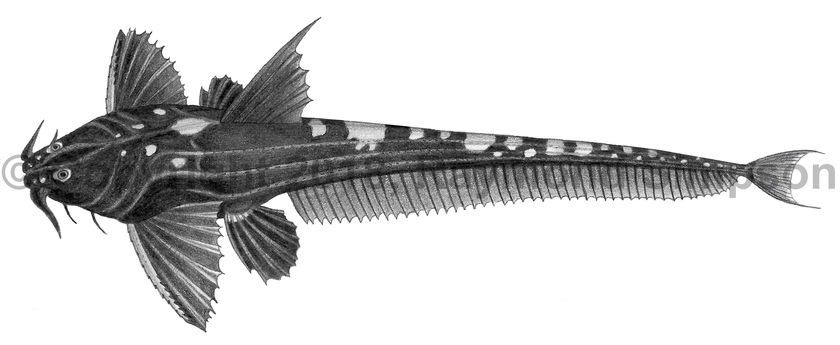
Common Name
Banded Banjo Catfish
Year Described
Bloch, 1794
Identification
Dorsal Fin: 5
Anal Fin: 50-60 rays
Caudal Fin: 9 principal rays
Pectoral Fin:
Body distinctively banjo-shaped with the body flattened and wide anterior to anal fin origin, and posterior part of body thin and laterally compressed. Head armored. Gill opening on underside of head. Thick part of body at least a third of standard length. Snout tapers rapidly to a blunt tip and a small mouth. Maxillary barbels moderate; almost reach pectoral fins. No accessory barbels at base of maxillary barbel. Maxillary barbels have a fleshy flap connecting to head. Underside of body with only 2 pairs of barbels. Dorsal fin high with a short base, filament and weak spine. Anal fin very long based. Pectoral fins large with strong spines and coarse serrations. Pelvic fin rounded. Adipose fin absent. Caudal fin small. Body naked except for well developed rows of tubercles. Four distinct ridges on body.
Color
Body ranges from uniformly dark brown to almost black. Sometimes has scattered whitish blotches and saddles. Fins all dark.
Size
Maximum size to 32cm SL.
Habitat
Inhabits the lower reaches of rivers and into brackish and saltwater estuaries. Found over soft bottoms.
Range
Venezuela and Brazil (Orinoco and Amazon basins).
References
Carpenter, K.E., & De Angelis, N. (Eds.). 2002. The living marine resources of the Western Central Atlantic (Vol. 2, pp. 602-1373). Rome, Italy: Food and agriculture organization of the United Nations.
van der Sleen, P., & Albert, J.S. (Eds.). 2017. Field guide to the fishes of the Amazon, Orinoco, and Guianas (Vol. 115). Princeton University Press.